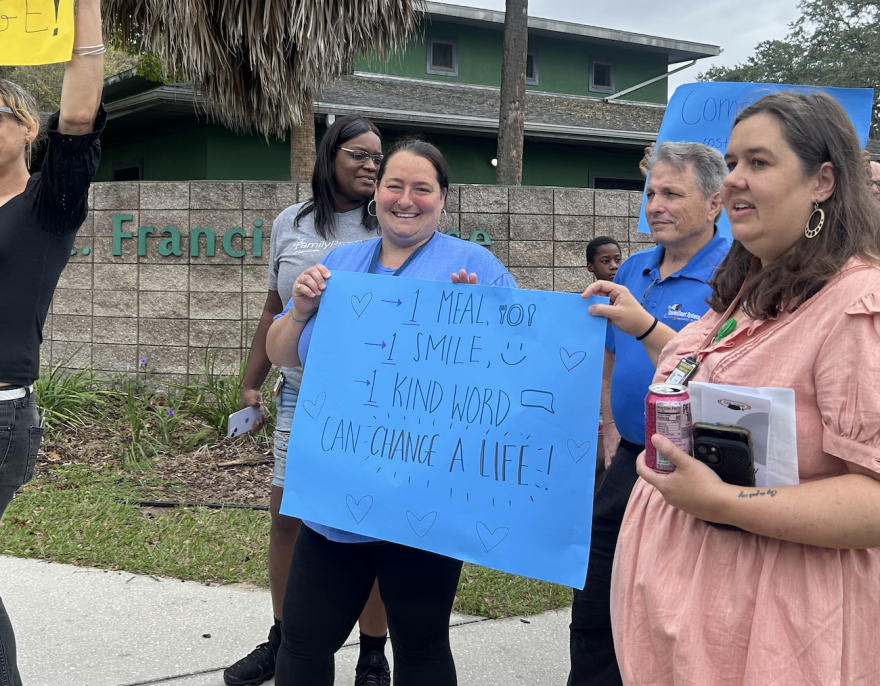Questions in Gainesville remain in regard to food assistance in the midst of the government shutdown that began Oct. 1.
Two federal judges on Friday said the Trump administration had to use contingency funds to make payments for the Supplemental Nutrition Assistance Program (SNAP).
However, uncertainty lingered. In Boston, U.S. District Judge Indira Talwani gave the Trump administration until Monday to decide to pay at least partial SNAP food benefits. In Rhode Island, U.S. District Chief Judge John James McConnell Jr. gave the administration a deadline of noon Monday to submit a plan of compliance or at least an update.
But in a declaration Monday for the District of Rhode Island, Department of Agriculture official Patrick Penn, who oversees SNAP, wrote that the administration “intends to deplete SNAP contingency funds completely and provide reduced SNAP benefits for November 2025.”
In Gainesville, homeless shelter directors remain concerned about the impact of a delayed response from the government.
About 33,000 people in Alachua County relied on food stamps in 2022, according to the Federal Reserve Bank of St. Louis. Based on a post by the official Alachua County Facebook account, approximately 10% of county residents rely on SNAP.
Rachael Ryan, the interim executive director of the homeless service Family Promise of Gainesville, said there are still unanswered questions.
“Even with that ruling, there is still an immense amount of uncertainty because it’s been shown that the world today is very unpredictable,” she said. “We just don’t know what to expect.”
Family Promise of Gainesville currently has 1,733 individuals experiencing homelessness, including 1,033 children. Two-thirds of those people rely on food stamps, Ryan said.
And Family Promise of Gainesville is not the only shelter adjusting to accommodate as many homeless and food insecure individuals as possible. Lauri Schiffbauer, the executive director of St. Francis House, said the situation remains unresolved.
“The repercussions are pretty far-reaching in terms of what's going on with this government shutdown,” she said. “[Shelter residents] are going to have to really make some tough decisions because we have no idea how long this is going to go on now.”

But even with the Trump administration agreeing to use contingency funds to help pay for food stamps, it will not be enough to accommodate everyone. According to the U.S. Department of Agriculture’s Economic Research Service, SNAP costs around $8 billion a month. In the declaration, Penn wrote that $4.65 billion from the contingency plan will be used to fund SNAP this month.
“We all need to be concerned about this,” Schiffbauer said. “I would encourage people to understand that just because it's not you doesn't mean it's not happening.”
For St. Francis House, which has overnight residents but also serves clients daily from 9 a.m. to noon, nonperishable items and can openers are especially necessary.
Dr. Ana Turner, a community psychiatrist offering her expertise and knowledge at the homeless shelter I.M. Sulzbacher Center in Jacksonville, said donating to local food pantries and homeless shelters, as well as writing to local representatives, can make a difference.
“I think it’s going to be a big deal because so many people struggle with hunger, not just people on the streets,” she said. “It’s just going to be really hard for a lot of people to get access to food.”
Turner said she was not initially worried about the government shutdown impacting food stamps because those at the I.M. Sulzbacher Center and herself assumed the contingency fund would be used from the start. When the group found out that receiving funds would be much more complicated, they began scrambling to find ways to help those they serve.
For individuals like 33-year-old Lyndon Boykins Jr., uncertainty about when they’ll receive food stamps in November means having to be more frugal. He usually receives $804 a month for his three children.
“In the whole world, I feel like everybody should have access to food and resources,” Boykins Jr. said. “Not having it, you don't have that brace to get over that gap of life and stuff that you get used to doing.”
The contingency fund is only obligated to cover 50% of eligible households’ current allotments, according to the declaration.
Until the payments begin going out for the month of November, people experiencing homelessness and other low-income individuals must find food resources or reallocate other funds toward food spending.
“Now they gotta be in survival mode. Now they gotta do things they wouldn't normally do just to make money, just to make ends meet,” Boykins Jr. said. “I feel like that's kind of symbolic of the end times, or the end of a certain system that we've grown accustomed to.”

